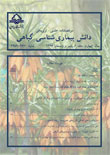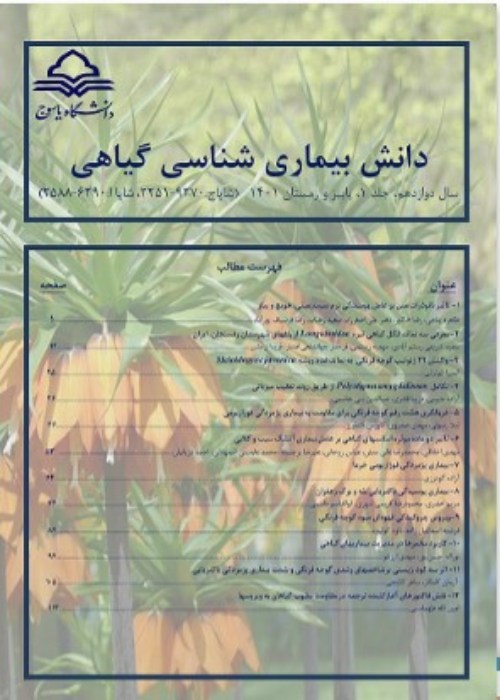فهرست مطالب

نشریه دانش بیماری شناسی گیاهی
سال چهارم شماره 2 (پیاپی 8، بهار و تابستان 1394)
- تاریخ انتشار: 1394/07/30
- تعداد عناوین: 6
-
-
صفحات 1-16نماتد سیست سویا در اکثر کشورهای تولید کننده سویا در دنیا گسترش داشته و به عنوان یکی از مهم ترین عوامل خسارتزای این محصول محسوب می گردد. در ایران نماتد سیست سویا اولین بار در سال 1378 از شمال کشور گزارش شد. در حال حاضر این نماتد در استان های گلستان و مازندران گسترش دارد، میزان آلودگی در مزارع از دامنه وسیعی برخوردار است و در اکثر مزارع آلوده در هر دو استان در زمان برداشت محصول و همچنین قبل از کاشت سویا میزان جمعیت بالاتر از حد آستانه زیان اقتصادی است که برای این نماتد ذکر شده است. نژادشماره 3 یا Hg Type 0 به عنوان نژاد غالب و رقم کتول (DPX) تنها رقم مقاوم سویا به این نماتد در ایران تعیین شده است. در این مقاله اهمیت نماتد سیست سویا، پراکنش و شدت آلودگی، شکل شناسی نماتد و نشانه های آلودگی در مزرعه، نژاد یا تیپ (Hg Type)، چرخه زندگی، واکنش ارقام سویا نسبت به نژاد غالب در ایران و مدیریت آن براساس پژوهش های انجام شده در ایران و جهان شرح داده شده است.
کلیدواژگان: پراکنش، سویا، مدیریت، نژاد، نماتد -
صفحات 17-25دانه های لوبیا، نخود، عدس، ماش و باقلا سرشار از پروتئین هستند. استان کهگیلویه و بویر احمد، یکی از مناطق کشت این گیاهان است. پنج بیماری مهم قارچی پژمردگی فوزاریومی، پوسیدگی فوزاریومی ریشه، سوختگی آسکوکیتایی، سوختگی آلترناریایی و پوسیدگی ذغالی در این استان روی این گیاهان شایع هستند. نشانه های این بیماری ها، خصوصیات کلیدی ریخت شناسی بیمارگرها و مناطق انتشار آن ها در ایران و جهان شرح داده شده است.
کلیدواژگان: لوبیا، نخود، Alternaria، Fusarium، Mycosphaerella -
صفحات 26-40بیماری آنتراکنوز یکی از مخرب ترین بیماری های توت فرنگی است که توسط سه گونه قارچ Colletotrichum acutatum، C. gloeosporioides و C. fragariae ایجاد می شود. دو گونه C. acutatum و C. gloeosporioides دارای دامنه میزبانی وسیع تری هستند و بر اساس آخرین ارزیابی های تبارزایی چند ژنی جدایه های متعدد عامل آنتراکنوز توت فرنگی جمع آوری شده از مناطق مختلف دنیا متعلق به این دو گونه، در چندین خوشه مختلف مربوط به گونه های مخفی دسته بندی می شوند. گونه C. acutatum علیرغم آلوده کردن اکثر اندام های گیاه، عمدتا عامل پوسیدگی میوه بوده و نسبت به دو گونه دیگر که در ارتباط با پوسیدگی طوقه شناخته شده هستند، فراگیرتر و خسارت زاتر می باشد. انتشار زادمایه بیماری توسط قطرات باران یا آبیاری بارانی، انسان و حیوانات صورت می گیرد. مدیریت تلفیقی بیماری شامل روش های زراعی، شیمیایی، زیستی و استفاده از ارقام مقاوم است. با توجه به اهمیت بیماری آنتراکنوز توت فرنگی از لحاظ میزان خسارت و شیوع اخیر آن در مناطق کشت و پرورش این محصول در ایران در این مقاله نحوه تشخیص صحیح عامل بیماری، جنبه های زیست شناستی و روش مدیریت بیماری شرح داده شده است.
کلیدواژگان: آنتراکنوز، تبارزایی، توت فرنگی، زیست شناسی، مدیریت -
صفحات 41-52شناسایی دقیق قارچ ها و شبه قارچ ها یکی از مهم ترین گام ها برای یافتن راه کاری برای استفاده یا مبارزه با آن ها بوده است. ولی این فرآیند معمولا زمان گیر و پرزحمت است. کلیدهای برهم کنشی یکی از راه کارهای کاهش این زمان و شناسایی دقیق گونه ها است. کلید برهم کنشی برنامه ای رایانه ای است که در آن کاربر صفات ریختی و یا مولکولی نمونه ی مورد نظر را وارد می کند و برنامه آن ها را با داده های موجود مقایسه می کند تا به گونه ی مورد نظر یا گونه ای که بیش ترین شباهت را با نمونه ی مورد مطالعه داشته باشد، برسد. این کلیدها برای هر گونه ی شناخته شده تصاویر و اطلاعات جداگانه ای دارند. در این مقاله تعدادی از این کلیدها و نحوه ی کارکرد آن ها معرفی شده اند.
کلیدواژگان: Trichoderma، Fusarium، Phytophthora، Tilletia -
صفحات 53-63قارچ های Olpidium brassicae و O. boronovanus و دو گونه شبه قارچ Polymyxa graminis و P.betae به عنوان ناقلین مهم ویروس های گیاهی شناخته شده اند. تمامی این قارچ ها و شبه قارچ ها انگل اجباری ریشه گیاهان می باشند و ویروس های متعلق به 12 جنس در 4 خانواده را منتقل می کنند. در این مقاله ضمن معرفی این ناقلین و چرخه ی زندگی آن ها، ویروس هایی که منتقل می کنند و نحوه ی کسب و انتقال ویروس ها شرح داده شده اند.
کلیدواژگان: خاک برد، ویروس، Olpidium، Polymyxa -
صفحات 73-64دانش رو به پیشرفت بررسی عملکرد و تکامل هم زمان ژن های مقاومت در گیاهان با ژن های پرآزاری در بیمارگرها، فرصت جدیدی را برای ایجاد مقاومت پایدار در برابر بیماری های گیاهی فراهم ساخته است. این مقاله، یافته های نوین در مورد ژنتیک انواع مقاومت، عملکرد و تکامل ژن های مقاومت دخیل در تشخیص بیمارگر، پیام رسانی و پاسخ به بیمارگر، را شرح می دهد.
کلیدواژگان: بیماری، پایدار، تکامل هم زمان، ویروس
-
Pages 1-16Soybean cyst nematode, Heterodera glycines, is widespread in major soybean producing countries and is considered as the most suppressed agent of soybean yield in the world. This nematode was reported from northern Iran in 1999 for the first time. Presently SCN is widely distributed in Golestan and Mazandaran provinces and infestation rate is a remarkable showing broad range of infestation. In most fields, the population density is above the damage threshold level reported for this nematode in the literatures. The HG Type 0 (race 3) has been defined as the dominant type in the region and Katoul (DPX) is the only resistant cultivar to this type of SCN in Iran. Importance of soybean cyst nematode, distribution and severity of infection, nematode morphology, symptoms, race/Hg Type, life cycle, reaction of Iranian cultivars against the dominant SCN Hg Type in Iran, and its management, based on the researches conducted in Iran and in the world are presented in this paper.Keywords: Distribution, Soybean, Management, Race, Nematode
-
Pages 17-25Bean, pea, lentil, vetch and broad bean grains are rich in protein. Kohgiluyeh and Boyer-Ahmad (a province in the southwest Iran) is one of the cultivation area of the pulses. In this province, five important fungal diseases included Fusarium wilt, Fusarium root rot, Ascochyta blight, Alternaria blight, and charcoal rot, are common on these plants. Symptoms of these diseases, key morphological characteristics of the pathogens and their distribution areas in Iran and the world is described.Keywords: Bean, Chickpea, Alternaria, Fusarium, Mycosphaerella
-
Pages 26-40Anthracnose disease is one of the most destructive diseases of strawberry which caused by Colletotrichum acutatum, C. gloeosporioides and C. fragariae. C. acutatum and C. gloeosporioides species complexes possess wider host range. According to the latest multi-gene phylogenetic evaluation, different strains of the causal agent of strawberry anthracnose disease which have been collected from different regions of the world, belong to these two species and are divided into several clusters, related to cryptic species. Despite infecting various parts of the plant, C. acutatum is mostly responsible for fruit rot and in comparison with two other species, causes crown rot and is more prevalent and destructive. Dispersal of pathogen inoculums mainly takes place by rain splash and sprinkler irrigation as well as by movement of human beings and animals. Integrated management of this disease is mainly achieved through cultural, chemical, biological and the use of resistant cultivars. Giving the importance of strawberry anthracnose disease in terms of damage rate and its recent incidence in many strawberry growing areas in Iran, different aspects of the disease, including diagnosis of the causal agent, biology and efficient management methods are discussed in the present review.Keywords: Anthracnose, Phylogeny, Strawberry, Biology, Management
-
Pages 41-52Accurate identification of fungi and fungus-like organisms is one of the most important steps for finding an approach to employ or control them. Nevertheless, this process is usually laborious and slow. Application of interactive keys is one of the ways to save the time and have an accurate identification of the species. An interactive key is a computer program in which the user enters morphological or molecular attributes of the specimen and the program compares them with the data of its database to find a match species with the highest similarity. Such keys also allocate separate images and other data for any known species. In this paper some of the interactive identification keys and their function is discussed.Keywords: Trichoderma, Fusarium, Phytophthora, Tilletia
-
Pages 53-63The fungi Olpidium brassica and O. boronovanus, and two fungal-like species, Polymyxa beta and P. graminis, are known as important vectors of plant viruses. All of these microorganisms are obligate parasite of root and transmit the viruses belong to at least 12 genera and four families of plant viruses. In this paper, these vectors and their life cycle, transmitted viruses, methods of the acquiring and transmission of them are described.Keywords: Soil, borne, Polymyxa, Olpidium, Virus
-
Pages 73-64With studying the function and co evolution of the plant resistance genes with virulence genes in the pathogens, the knowledge of molecular genetics is in progress and creates a new opportunity to produce durable resistance against plant diseases. This article explains the new findings about the different varieties of genetic resistance, performance and evolution of resistance genes involved in detecting, signaling and responding to plant pathogens.Keywords: Disease, Durable, Co evolution, Virus


